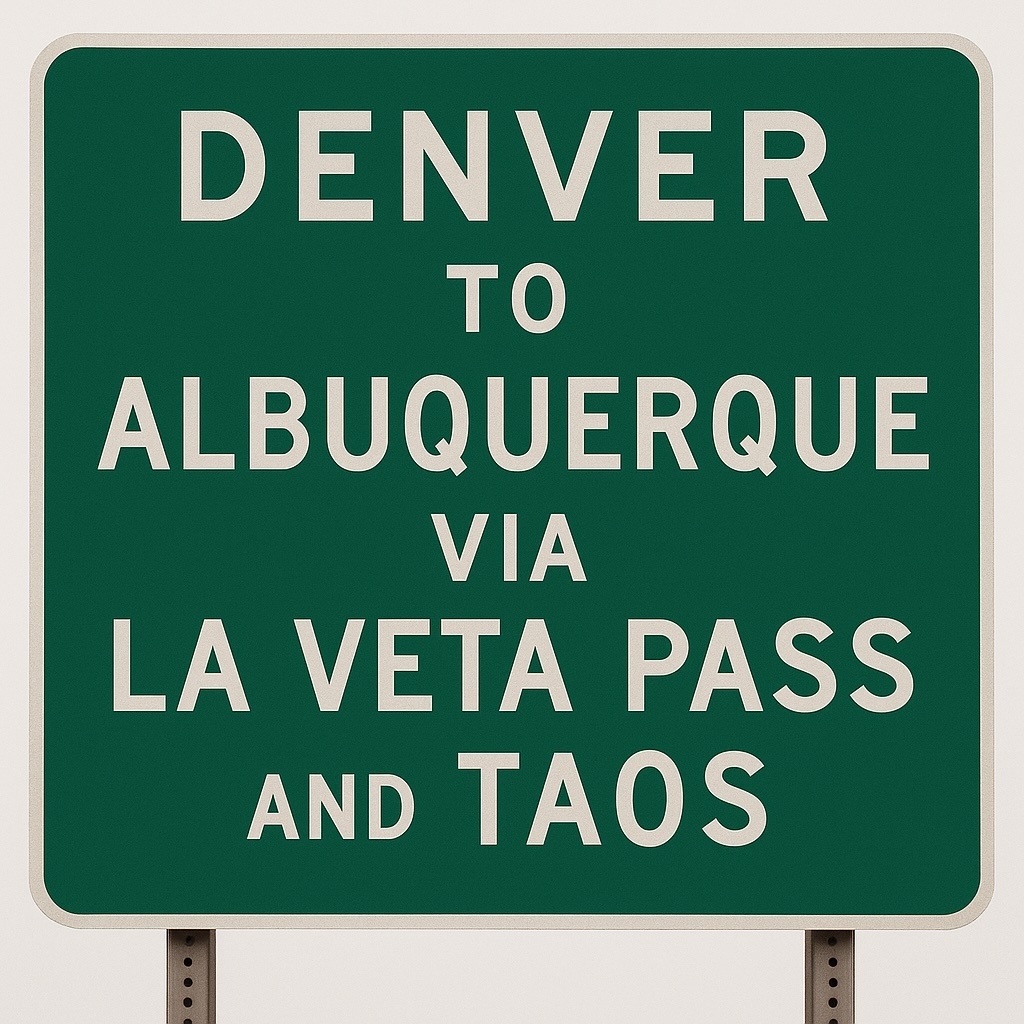
If a visit to Albuquerque is in your plans and you want to get there ‘quickly’, jump on one of the 54 weekly flights out of Denver International Airport. But, as you may have guessed, quickly does not necessarily mean quick.
You’ll need to calculate the time it takes getting to DIA. From the southern suburbs, say, Douglas County, add as much as an hour. Budget in TSA’s mandated airport arrival time, gate time and hope everything’s on time. Clock’s still ticking.
On board, add taxi time, flight time—70-80 minutes—deplaning and luggage retrieval. That’s four hours, maybe more. Next time, consider ‘the road less traveled.’
Interstate 25—the road ‘most traveled’—from Denver takes you south to Walsenburg where you leave the interstate. From there, head west on U.S. 160. You’ll navigate a winding, elevating La Veta Pass with its incredible scenic wonders and, a few miles later, hit Fort Garland, amazing vistas and history. Make sure you visit the local history museum.
The museum tells Fort Garland’s history from 1858 on. It includes how it was included in the Treaty of Guadalupe Hidalgo, the fight for the land, the tribes who once lived here and the Buffalo soldiers who once defended it. It’s a quick but fascinating stop.
Next, just fifteen miles south on state highway 159, is San Luis, Colorado’s oldest town. Though just populated by some 600-plus residents, it has the bloodlines of the state’s earliest, non-native settlers, the Spaniards who trekked here from New Mexico in the mid-19th century.
While resident and world famous artist Huberto Maestas’ Stations of the Cross is the town’s most visited site, its history, said San Luis Town Manager, Teddy Leinbach, is every bit as fascinating. “You can really feel history (here),” said Leinbach. “You can see it in the architecture and hear it in the dialect,” a dialect spoken by long ago Spanish settlers. “You feel the influence of the 1800’s.”
Surrounding San Luis are satellite villages—Chama, San Francisco, San Pablo and Garcia, the oldest of them all. “There’s still so much pride in these little communities,” Leinbach said. Each still has its own stores and churches. “Driving around here is just incredible.” But everyone, he said, has a hand in San Luis’s Fiesta de Santiago de Santana, the summer’s big celebration held the last weekend of July.
Twenty minutes you arrive in the small village of Costilla where the beautiful Rio Costilla Park in Amalia is known for its fishing, hunting, hiking and camping. Costilla and Amalia celebrated 175 years of settlement in 2023, attracting thousands of past and present residents.
Another twenty miles down the road on Highway 522 you arrive in Questa, home of the Questa Highschool Wildcats and the Veterans Flag Memorial highlighted with hundreds of American flags in view every Memorial Day.
An half hour south is Taos. Over the years, Taos, nestled comfortably in the shadow of the Sangre de Cristo mountains, is a town whose recorded history goes back to 1615 and has become a destination stop both for its art and history.
While Taos’ recorded history spans four centuries, Native Americans have occupied the region for more than a thousand years. Today, Taos Pueblo, connected to the town’s northern border, draws thousands of visitors each year.
Taos is often written about in an almost mystical way. Stories about its high country beauty abound. That, coupled with its history, said Taos native and current resident Jacob Herrera make it special. Not to be outdone, a few miles from the Taos Pueblo sits Taos Mountain Casino for gaming entertainment.
Also, along the way a few wineries provide some of the finest wines available. (Please don’t drink and drive).
“It is unique,” said Herrera, general manager at the Taos County Club. From anywhere on the property, which includes the contrasting blue of the Taos mountains and the seasonal come to life sage brush of the high desert, the views are spectacular. There is also one of the top and most challenging golf courses in the state. That’s just for starters.
“You see the elk that come down in the winter,” he said. You hear them bugling and see “coyotes, fox, weasels, quail, and roadrunners.” In the late winter you can also see migrating cranes. In summer, pelicans drop by for a visit.
In town, said Herrera, there are excellent restaurants offering world-class dining as well as family joints with signature New Mexico fare. ‘Christmas, (both) or Red or green,’ is a question asked with each order of a Mexican dish. (You’ll figure it out.)
In Taos, you’ll also find the Kit Carson House and Museum. There, you can see and learn the history of one of the West’s most famous scouts, traders and soldiers.
Not far away is Rancho de Taos. It’s a must-see for taking a peek into the past. Its 21 buildings, which include San Francisco de Assisi Mission Church, echo a time long ago in both awe and fascination.
The architecture of Taos is a blurry look into a rich and colorful past. All by itself, the Plaza reflects a heritage of the West that combines Native American, Spanish and Mexican cultures.
Off the beaten path, but still nearby, are things that have their own charm and fascination. There is El Santuario de Chimayo, a special and spiritual stop revered by Catholics. It’s a 50-mile side trip from Taos.
While Taos is the nerve center of this stretch of northern New Mexico, Herrera said the Rio Grande River is special to locals, including himself. “I do love stopping at the Rio, getting my feet wet,” and just taking in the soft melody of silence.
On the way to Santa Fe, the last stop before Albuquerque, Herrera said you’ll pass through Espanola (the low-rider capital of the world as featured in 60 Minutes this year) and Mesilla, There are several casino stops like Ohkay Casino, Santa Clarin Casino, Cities of Gold, Buffalo Thunder along the way for those inclined. But, in the end, said Herrera, to him, everything begins and ends in Taos. “It’s the best thing about New Mexico.”


